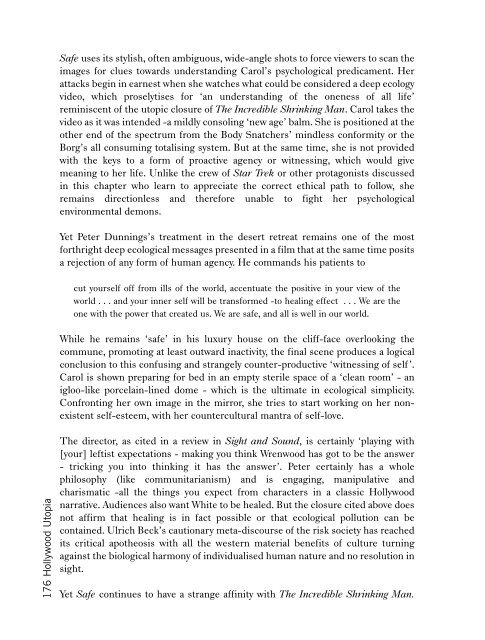Hollywood Utopia
Hollywood Utopia
Hollywood Utopia
You also want an ePaper? Increase the reach of your titles
YUMPU automatically turns print PDFs into web optimized ePapers that Google loves.
176 <strong>Hollywood</strong> <strong>Utopia</strong><br />
Safe uses its stylish, often ambiguous, wide-angle shots to force viewers to scan the<br />
images for clues towards understanding Carol’s psychological predicament. Her<br />
attacks begin in earnest when she watches what could be considered a deep ecology<br />
video, which proselytises for ‘an understanding of the oneness of all life’<br />
reminiscent of the utopic closure of The Incredible Shrinking Man. Carol takes the<br />
video as it was intended -a mildly consoling ‘new age’ balm. She is positioned at the<br />
other end of the spectrum from the Body Snatchers’ mindless conformity or the<br />
Borg’s all consuming totalising system. But at the same time, she is not provided<br />
with the keys to a form of proactive agency or witnessing, which would give<br />
meaning to her life. Unlike the crew of Star Trek or other protagonists discussed<br />
in this chapter who learn to appreciate the correct ethical path to follow, she<br />
remains directionless and therefore unable to fight her psychological<br />
environmental demons.<br />
Yet Peter Dunnings’s treatment in the desert retreat remains one of the most<br />
forthright deep ecological messages presented in a film that at the same time posits<br />
a rejection of any form of human agency. He commands his patients to<br />
cut yourself off from ills of the world, accentuate the positive in your view of the<br />
world . . . and your inner self will be transformed -to healing effect . . . We are the<br />
one with the power that created us. We are safe, and all is well in our world.<br />
While he remains ‘safe’ in his luxury house on the cliff-face overlooking the<br />
commune, promoting at least outward inactivity, the final scene produces a logical<br />
conclusion to this confusing and strangely counter-productive ‘witnessing of self’.<br />
Carol is shown preparing for bed in an empty sterile space of a ‘clean room’ - an<br />
igloo-like porcelain-lined dome - which is the ultimate in ecological simplicity.<br />
Confronting her own image in the mirror, she tries to start working on her nonexistent<br />
self-esteem, with her countercultural mantra of self-love.<br />
The director, as cited in a review in Sight and Sound, is certainly ‘playing with<br />
[your] leftist expectations - making you think Wrenwood has got to be the answer<br />
- tricking you into thinking it has the answer’. Peter certainly has a whole<br />
philosophy (like communitarianism) and is engaging, manipulative and<br />
charismatic -all the things you expect from characters in a classic <strong>Hollywood</strong><br />
narrative. Audiences also want White to be healed. But the closure cited above does<br />
not affirm that healing is in fact possible or that ecological pollution can be<br />
contained. Ulrich Beck’s cautionary meta-discourse of the risk society has reached<br />
its critical apotheosis with all the western material benefits of culture turning<br />
against the biological harmony of individualised human nature and no resolution in<br />
sight.<br />
Yet Safe continues to have a strange affinity with The Incredible Shrinking Man.
















